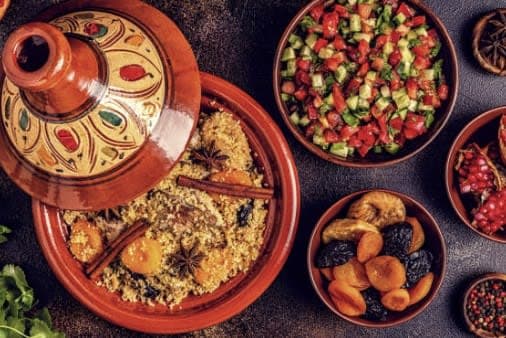Moroccan cuisine
moroccan food tasting
The base of Moroccan cooking includes fresh vegetables like tomatoes, carrots, onions, and eggplants. Fruits like dates, figs, and oranges are added for sweetness, especially in dishes like tagines. Meats like lamb, beef, and chicken are commonly used, slow-cooked with spices such as cumin, paprika, cinnamon, turmeric, and ginger. These spices aren’t just flavor, they carry memories of trade, travel, and connection with many cultures.
Here are some examples of traditional Moroccan dishes that show the richness of our culture and flavors:
Mint tea is Morocco’s drink of welcome. Made with green tea, fresh mint, and sugar, it is served in small glasses and poured from high above. Tea is not rushed. It invites conversation, comfort, and time. To offer tea is to say, “You are welcome, sit, stay, talk.”
Tagine is one of Morocco’s most famous dishes. It is a stew cooked slowly in a cone-shaped clay pot. The meat becomes soft, and the flavors mix together over time. Some tagines include prunes and almonds. Others have olives and preserved lemons. Each version reflects the region, the season, and the story behind the cook.
Couscous is another beloved dish. On Fridays, after prayer, families gather for couscous served with vegetables, tender meat, and broth. It is more than food, it is an act of gathering, a ritual of peace. Couscous shows how grain, water, and patience can create harmony
Pastilla is a dish made with thin pastry and filled with spiced chicken or pigeon, almonds, and cinnamon. It is sweet and savory at the same time, often served at weddings and special celebrations. Harira, a soup made with tomatoes, chickpeas, lentils, and meat, is served during Ramadan, it carries warmth and care, helping people break the fast gently.
Mechoui is a dish made for big occasions whole lamb, roasted slowly, flavored with salt and cumin, eaten with hands and laughter.
Rfissa: made with chicken, lentils, and shredded bread soaked in broth, is a dish of generosity and healing, often served to new mothers, showing care and respect.
Bread is at the center of every meal. Thick and round, Moroccan bread is used as a spoon and symbol of sharing. To break bread with someone means to trust them. In many villages, bread is baked in shared ovens, connecting neighbors and families.
Moroccan food also changes from region to region. In the north, seafood and olives bring freshness. In the south, dates and spices bring warmth. In the mountains, simple stews and bread feed both body and soul. Every dish tells you where it comes from and who made it with love, with memory, with meaning.
Eating in Morocco is more than a taste, it’s an experience. You eat with your hands. You sit close. You talk. You listen. Food becomes a bridge between generations, between strangers, between cultures. Even in a small café, you will feel the welcome in a bowl of lentils or a plate of grilled sardines.
Behind each spice is a story, Behind each dish is a reason. Moroccan food is not just delicious, t is thoughtful, It celebrates the past and embraces the present. In every kitchen, you feel Morocco’s warmth. In every bite, you taste its spirit.


